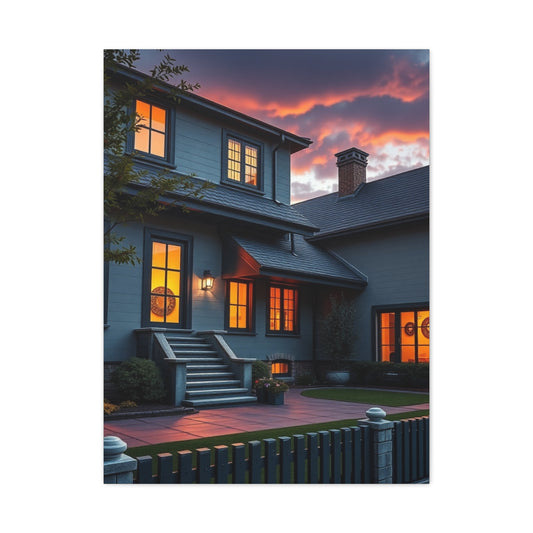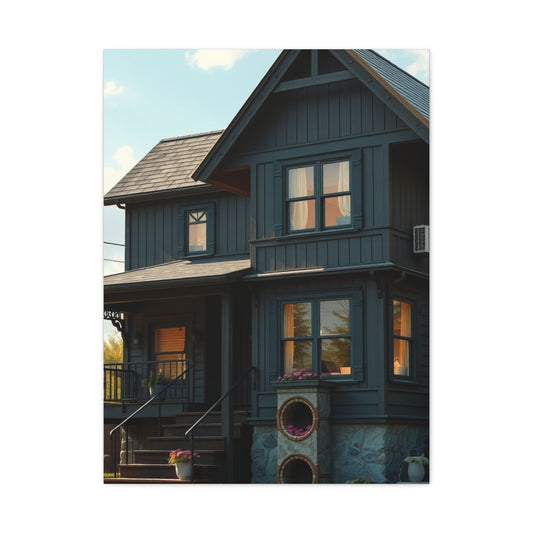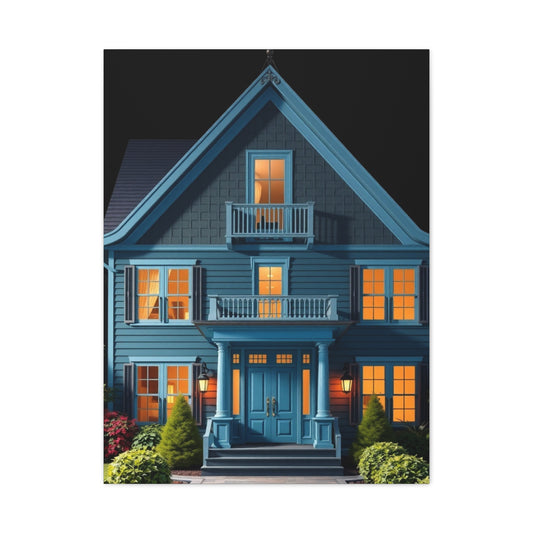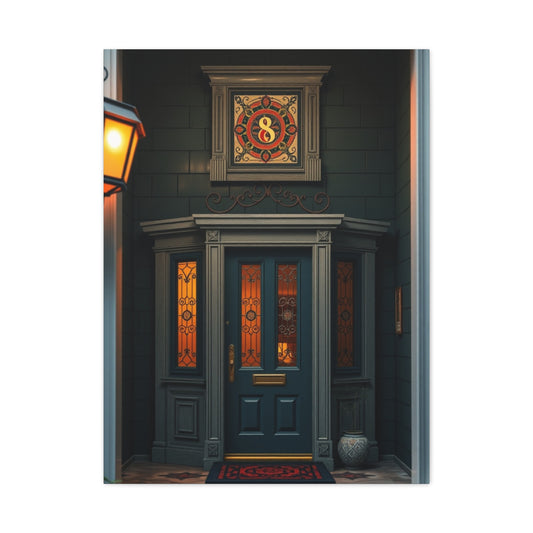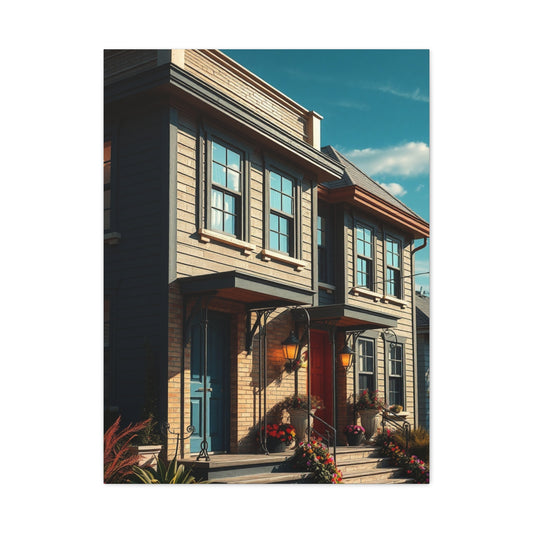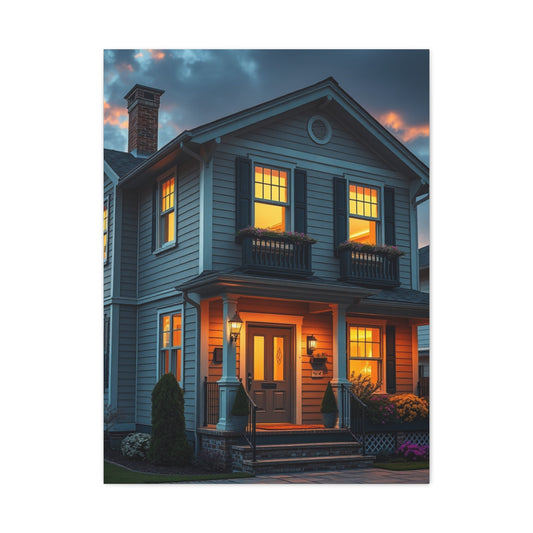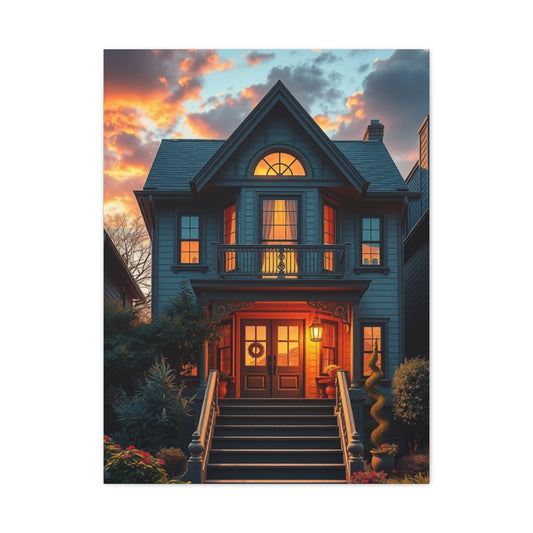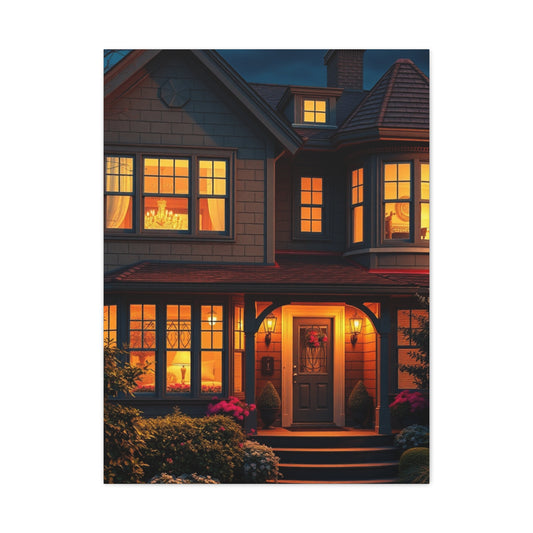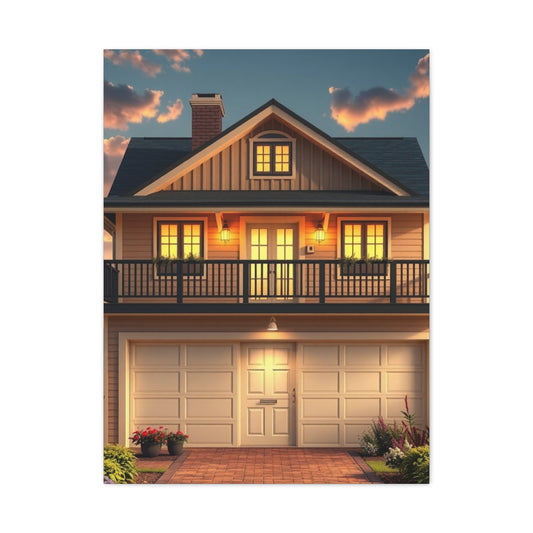Stylish Home Makeovers Using House Dwelling Wall Art and Canvas Décor
The art of adorning residential spaces with carefully selected visual elements has evolved into a sophisticated practice that transcends mere decoration. Today's homeowners understand that the strategic placement of cozy home wall prints and house dwelling canvas art serves as the cornerstone of interior design excellence. These artistic expressions breathe life into otherwise mundane walls, transforming sterile environments into sanctuaries of personal expression and aesthetic refinement.
The contemporary home represents far more than a simple shelter from external elements. It embodies our deepest aspirations, reflects our cultural sensibilities, and provides the backdrop against which our most cherished memories unfold. Within this context, charming home wall décor emerges as a powerful tool for crafting environments that resonate with inhabitants on profound emotional levels. The careful curation of visual elements creates atmospheric conditions that influence mood, productivity, and overall well-being in measurable ways.
Modern house prints have revolutionized the traditional approach to residential decoration by offering unprecedented versatility and accessibility. Unlike their predecessors, which often required substantial financial investment and extensive knowledge of art history, today's printing technologies democratize access to museum-quality reproductions and original digital creations. This technological advancement enables homeowners to experiment with diverse aesthetic approaches without committing to permanent installations or exhausting discretionary budgets.
The psychology of residential spaces reveals fascinating insights into human behavior and environmental interaction. Researchers consistently demonstrate that thoughtfully designed interiors significantly impact cognitive function, emotional regulation, and social dynamics. Rustic dwelling canvas pieces, for instance, evoke feelings of warmth, security, and connection to natural environments, while minimalist home wall art promotes mental clarity and reduces visual overwhelm in increasingly chaotic modern lifestyles.
Residential Wall Decoration
The foundation of successful wall decoration begins with comprehensive understanding of spatial relationships, color theory, and psychological principles that govern human perception. Architectural house canvas selections must harmonize with existing structural elements while simultaneously introducing dynamic visual interest that prevents monotony. This delicate balance requires careful consideration of proportion, scale, and thematic coherence across diverse residential environments.
Scale represents perhaps the most critical factor in achieving visual harmony within residential spaces. Oversized artwork can overwhelm intimate areas, while undersized pieces disappear against expansive wall surfaces. Professional interior designers recommend measuring wall dimensions precisely and selecting artwork that occupies approximately sixty to seventy-five percent of available wall space for optimal visual impact. This principle applies universally across different stylistic approaches, from cute home wall prints to sophisticated contemporary installations.
Color coordination extends beyond simple matching schemes to encompass complex relationships between hues, saturation levels, and tonal variations. Warm dwelling wall décor featuring earth tones and natural palettes creates inviting atmospheres that encourage relaxation and social interaction. Conversely, cooler color schemes promote focus and productivity, making them ideal choices for home offices and creative workspaces. Understanding these psychological associations enables homeowners to craft environments that support specific activities and emotional states.
Lighting conditions profoundly influence how artwork appears within residential settings. Natural illumination changes throughout daily cycles, affecting color perception and visual clarity in predictable patterns. House illustration canvas pieces positioned near windows benefit from abundant natural light during daylight hours but may require supplementary artificial illumination for evening appreciation. Conversely, artwork placed in interior areas depends entirely upon artificial lighting systems, necessitating careful consideration of bulb temperature, intensity, and directionality.
The concept of visual weight plays crucial roles in achieving balanced compositions across wall surfaces. Darker colors, complex patterns, and highly detailed imagery possess greater visual weight than lighter, simpler alternatives. Contemporary home wall art often employs strategic combinations of high and low visual weight elements to create dynamic equilibrium that guides viewer attention through carefully orchestrated visual journeys. This principle enables homeowners to establish focal points, create rhythm, and maintain viewer engagement across diverse architectural configurations.
Exploring Diverse Artistic Styles and Movements
The contemporary marketplace offers unprecedented access to artistic styles spanning centuries of human creative expression. Scenic house prints draw inspiration from landscape painting traditions that celebrate natural beauty and environmental harmony. These works connect interior spaces with outdoor environments, creating psychological bridges that expand perceived spatial boundaries and promote mental well-being through virtual nature exposure.
Traditional artistic movements continue influencing modern home decoration through reinterpretation and technological adaptation. Impressionist-inspired pieces capture fleeting moments and atmospheric conditions through loose brushwork and vibrant color applications. These characteristics translate beautifully to homely dwelling canvas formats, where digital printing technologies reproduce subtle textural variations and luminous color relationships that define this beloved artistic tradition.
Abstract expressionism offers bold alternatives for homeowners seeking dramatic visual statements. These non-representational works prioritize emotional expression over literal representation, enabling viewers to project personal interpretations and emotional associations onto ambiguous forms and color relationships. Artistic house wall style incorporating abstract elements provides flexibility for future interior design modifications while maintaining sophisticated aesthetic appeal across diverse decorative contexts.
Photorealistic approaches satisfy demands for precise representation and technical excellence. High-resolution printing technologies enable faithful reproduction of photographic imagery with remarkable detail and color accuracy. These elegant home canvas options appeal particularly to homeowners who appreciate technical mastery and prefer clearly defined subjects over interpretive artistic expressions. Wildlife photography, architectural studies, and botanical illustrations exemplify popular photorealistic categories.
Mixed media approaches combine traditional artistic techniques with contemporary materials and technologies. Digital artists increasingly incorporate hand-drawn elements, textural overlays, and photographic components to create unique hybrid works that resist easy categorization. These innovative approaches offer homeowners opportunities to acquire truly original pieces that reflect cutting-edge artistic developments while maintaining accessibility through digital reproduction methods.
Cultural and regional artistic traditions provide rich sources of inspiration for contemporary home decoration. Folk art traditions from diverse global cultures offer distinctive aesthetic alternatives that celebrate cultural heritage while introducing exotic visual elements into residential environments. Japanese woodblock printing techniques, Mexican folk art traditions, and Scandinavian design principles represent just a few examples of cultural influences shaping modern home wall art markets.
Material Considerations and Quality Factors
The physical characteristics of wall art significantly impact both aesthetic appeal and longevity within residential environments. Understanding material properties, production methods, and preservation requirements enables homeowners to make informed decisions that balance immediate visual gratification with long-term investment value and maintenance considerations.
Canvas materials range from traditional cotton and linen substrates to innovative synthetic alternatives engineered for enhanced durability and color retention. Rustic dwelling canvas pieces often employ textured surfaces that emphasize tactile qualities and artisanal craftsmanship associations. These materials provide visual depth and dimensional interest that flat printing surfaces cannot achieve, creating more engaging viewing experiences that reward close examination.
Paper-based substrates offer cost-effective alternatives for homeowners seeking high-quality reproductions without premium material expenses. Advanced printing papers incorporate archival properties that resist fading, yellowing, and environmental degradation over extended periods. These materials prove particularly suitable for minimalist home wall art applications where clean lines and precise detail reproduction take precedence over textural considerations.
Coating technologies protect printed surfaces from environmental hazards while enhancing visual characteristics. UV-resistant treatments prevent color fading from sunlight exposure, extending artwork lifespan significantly in naturally illuminated spaces. Moisture-resistant coatings enable placement in kitchens, bathrooms, and other high-humidity environments where traditional paper-based materials might suffer degradation.
Archival quality represents crucial considerations for homeowners viewing wall art as long-term investments. Museum-quality printing processes employ acid-free materials, lightfast inks, and protective coatings that maintain color integrity and structural stability for decades under normal residential conditions. Architectural house canvas pieces produced using archival methods justify higher initial costs through extended lifespan and maintained aesthetic appeal.
Printing resolution directly affects visual quality and viewing distance capabilities. High-resolution digital files enable large-format printing without visible pixelation or quality degradation, crucial for oversized installations or close viewing applications. Cute home wall prints benefit particularly from high-resolution production methods, where fine details and subtle color transitions contribute significantly to overall aesthetic impact.
Framing considerations extend beyond aesthetic preferences to encompass preservation and presentation requirements. Quality frames protect artwork edges from damage while providing structural support for larger pieces. Matting creates visual separation between artwork and frame elements while preventing direct contact that could cause damage over time. Protective glazing shields surfaces from dust accumulation, moisture exposure, and physical contact while maintaining visual accessibility.
Color Impact
Color relationships profoundly influence human psychology and environmental perception within residential spaces. Understanding these relationships enables homeowners to select warm dwelling wall décor that supports desired emotional states and functional requirements across diverse living environments.
Warm color palettes incorporating reds, oranges, and yellows create stimulating environments that promote social interaction and creative expression. These colors increase perceived temperature and create intimate atmospheres ideal for living rooms, dining areas, and entertainment spaces. However, excessive warm color exposure may contribute to overstimulation and emotional agitation in sensitive individuals, necessitating balanced applications with neutral or cool accent elements.
Cool color schemes featuring blues, greens, and purples promote tranquility and mental focus while creating impressions of expanded space and enhanced air circulation. These psychological associations make cool colors ideal for bedrooms, home offices, and meditation spaces where calm concentration supports primary activities. House illustration canvas pieces employing cool palettes contribute to stress reduction and improved sleep quality through environmental psychology mechanisms.
Neutral palettes provide flexible foundations that accommodate changing decorative preferences while maintaining sophisticated aesthetic appeal. Grays, beiges, and off-whites offer timeless elegance that transcends temporary fashion trends, making them wise choices for homeowners seeking long-term design stability. Contemporary home wall art in neutral tones adapts readily to seasonal decorative changes and furniture updates without requiring complete replacement.
Monochromatic approaches explore single color families through varied saturation and brightness levels, creating sophisticated compositions that demonstrate refined aesthetic sensibilities. These schemes prevent color conflicts while providing visual interest through tonal variation and textural contrast. Scenic house prints executed in monochromatic palettes emphasize form, composition, and lighting effects over chromatic relationships, appealing to viewers who appreciate subtle sophistication.
Complementary color relationships, based on opposite positions within color wheel configurations, create dynamic visual tension that attracts attention and maintains viewer engagement. These high-contrast combinations require careful application to prevent visual fatigue, but when properly balanced, they produce striking effects that transform ordinary spaces into memorable environments. Homely dwelling canvas pieces incorporating complementary schemes serve as powerful focal points within larger decorative contexts.
Cultural color associations influence perception and emotional response across different demographic groups and geographic regions. Understanding these variations enables homeowners to select artwork that resonates positively with intended audiences while avoiding unintended negative associations. Global markets increasingly demand sensitivity to diverse cultural perspectives, making cross-cultural color literacy valuable skills for contemporary interior design applications.
Innovations in Home Wall Art
Digital printing technologies continue revolutionizing accessibility, quality, and creative possibilities within home wall art markets. These innovations democratize access to high-quality reproductions while enabling entirely new categories of artistic expression that bridge traditional and contemporary aesthetic sensibilities.
Giclée printing represents the current standard for fine art reproduction, employing microscopic ink droplets to achieve unprecedented detail resolution and color accuracy. This technology enables faithful reproduction of original paintings, drawings, and photographs with museum-quality results that satisfy discriminating collectors and casual decorators alike. Artistic house wall style pieces produced through giclée methods maintain investment value while providing affordable access to masterwork reproductions.
Large-format printing capabilities remove size constraints that historically limited residential art options. Modern printing equipment produces seamless images exceeding eight feet in either dimension, enabling dramatic installations that transform entire wall surfaces into immersive visual experiences. These oversized elegant home canvas pieces create architectural elements that function as both decoration and spatial definition within open-plan residential layouts.
On-demand printing eliminates inventory requirements while enabling mass customization of artistic content. Customers select desired images from vast digital libraries, specify size parameters and material preferences, then receive custom-produced pieces within days rather than weeks. This efficiency reduces costs while increasing selection variety, making specialized artistic content accessible to broader consumer markets.
Digital art creation tools enable contemporary artists to produce original works specifically designed for residential applications. These purpose-built creations optimize color palettes, compositional elements, and thematic content for home environments rather than traditional gallery display contexts. The results often prove more suitable for residential integration than works originally conceived for institutional or commercial settings.
Variable data printing enables personalization of mass-produced artwork through individualized text, color modifications, or compositional adjustments. Homeowners can incorporate family names, meaningful dates, or location-specific elements into otherwise standard designs, creating unique pieces that reflect personal history and emotional connections. This customization capability bridges the gap between mass-market affordability and bespoke artistic commissioning.
Augmented reality applications allow customers to visualize artwork within their actual living spaces before making purchase decisions. These tools eliminate uncertainty about size, color coordination, and stylistic compatibility by superimposing virtual artwork onto photographed or live-streamed interior spaces. This technology significantly reduces return rates while increasing customer satisfaction with final installations.
Seasonal Decoration Strategies and Rotation Systems
Implementing seasonal rotation systems enables homeowners to maintain visual freshness while maximizing artwork investment value through varied display strategies. These approaches prevent decorative stagnation while accommodating changing preferences and environmental conditions throughout annual cycles.
Spring decoration emphasizes renewal, growth, and natural awakening through fresh color palettes and botanical imagery. Cozy home wall prints featuring flowering landscapes, garden scenes, and pastel color schemes create optimistic atmospheres that celebrate seasonal transition and encourage outdoor activity planning. These themes resonate particularly strongly in regions experiencing dramatic seasonal climate variations.
Summer installations maximize brightness and energy through bold colors, outdoor themes, and vacation-inspired imagery. Beach scenes, mountain vistas, and recreational activities provide escapist elements that extend vacation experiences into everyday residential environments. House dwelling canvas pieces featuring summer themes create psychological associations with leisure and relaxation that counterbalance work-related stress and routine pressures.
Autumn decorating traditions embrace harvest imagery, warm colors, and preparatory themes that acknowledge seasonal transition toward winter months. These installations often incorporate natural materials, earth tones, and cozy domestic imagery that prepare psychological space for increased indoor activity and social gathering. Charming home wall décor with autumn themes creates welcoming environments for holiday entertaining and family reunification activities.
Winter approaches emphasize comfort, security, and interior focus through darker palettes, intimate scales, and domestic themes. Fireplace scenes, snow-covered landscapes, and holiday imagery create protective psychological environments that support indoor activities and close social relationships. Modern house prints with winter themes acknowledge seasonal challenges while maintaining optimistic perspectives on indoor comfort and family connection.
Storage solutions for rotated artwork require careful planning to prevent damage while maintaining accessibility for seasonal transitions. Climate-controlled environments protect pieces from temperature fluctuations, humidity variations, and pest intrusion that could cause irreversible deterioration. Professional storage systems accommodate diverse sizes and materials while providing easy identification and retrieval capabilities.
Rotation scheduling prevents overwhelming decision-making while ensuring systematic variation throughout annual cycles. Many homeowners benefit from predetermined rotation dates that coincide with seasonal transitions, major holidays, or personal anniversaries. These scheduled changes create anticipated events that reinforce seasonal awareness while maintaining decorative variety without requiring constant attention or decision-making effort.
Budget-Conscious Approaches to Quality Wall Art
Developing impressive art collections within limited budgets requires strategic planning, creative resource utilization, and long-term investment perspectives that prioritize quality over quantity. These approaches enable homeowners to create sophisticated aesthetic environments without exhausting discretionary income or compromising other financial priorities.
Print-on-demand services offer exceptional value propositions by eliminating traditional retail markup structures while providing access to vast image libraries. Customers pay directly for production and shipping costs without supporting physical retail locations, extensive inventory systems, or sales staff compensation. Rustic dwelling canvas pieces purchased through these channels often cost fifty to seventy percent less than equivalent gallery purchases while maintaining comparable quality standards.
Digital marketplace platforms connect customers directly with independent artists and photographers, eliminating intermediary costs while supporting creative professionals. These transactions often provide better compensation for artists while reducing customer costs compared to traditional gallery representation models. Minimalist home wall art purchased directly from creators often includes personalization options and custom sizing unavailable through retail channels.
Subscription services provide access to rotating art collections at fixed monthly costs, enabling homeowners to experiment with diverse styles without permanent purchase commitments. These programs often include high-quality printing, professional framing, and convenient exchange services that support regular decoration updates. Architectural house canvas pieces accessed through subscription models allow risk-free exploration of contemporary artistic movements and emerging talent.
DIY printing approaches enable technically capable homeowners to achieve professional-quality results using consumer-grade equipment and materials. High-resolution digital files purchased online can be printed locally using professional printing services or advanced home printers, significantly reducing costs while maintaining quality standards. This approach proves particularly effective for cute home wall prints where precise color matching and archival longevity represent less critical factors.
Second-hand and consignment markets provide access to previously owned artwork at substantially reduced prices while supporting sustainable consumption practices. Estate sales, charity organizations, and online marketplaces frequently offer high-quality pieces from deceased collectors or downsizing homeowners. Warm dwelling wall décor acquired through these channels often includes original frames and professional mounting hardware that add substantial value to purchase prices.
Group purchasing arrangements enable individuals to achieve wholesale pricing through coordinated ordering with friends, family members, or community organizations. Many suppliers offer significant discounts for orders exceeding minimum quantity or value thresholds, making group purchases economically attractive for multiple parties. House illustration canvas pieces ordered collectively can reduce individual costs by twenty to forty percent while building community relationships through shared aesthetic interests.
Professional Installation and Display Techniques
Proper installation techniques ensure artwork security while maximizing visual impact and preventing damage to both walls and pieces. Professional-grade methods provide long-term stability while accommodating future rearrangement needs and diverse architectural conditions within residential environments.
Wall anchor selection depends on wall construction materials and artwork weight distribution characteristics. Drywall installations require hollow wall anchors rated for specific weight capacities, while masonry surfaces necessitate specialized fasteners designed for concrete or brick substrates. Contemporary home wall art installations must account for dynamic loading from air circulation, door operation, and structural settling that could compromise inadequate mounting systems.
Leveling tools ensure horizontal alignment that appears professional and visually satisfying. Laser levels provide precision alignment across multiple pieces while accommodating irregular wall surfaces and architectural features. Scenic house prints arranged in gallery configurations require consistent horizontal reference lines to maintain visual coherence despite varying individual dimensions and proportions.
Template systems enable accurate positioning before creating permanent mounting holes in wall surfaces. Paper templates cut to artwork dimensions allow experimental arrangement and precise marking without damaging walls through multiple drilling attempts. These preparation methods prove particularly valuable for homely dwelling canvas installations where permanent mounting prevents easy repositioning after initial installation.
Stud location techniques identify structural framing members that provide maximum support for heavier installations. Electronic stud finders detect wood or metal framing through drywall surfaces, enabling secure mounting for oversized pieces that exceed standard hollow wall anchor capabilities. Artistic house wall style installations often require structural mounting due to their dimensional characteristics and weight distribution patterns.
Wire hanging systems provide adjustment flexibility while distributing weight across multiple mounting points. Picture hanging wire accommodates minor leveling adjustments after installation while preventing single-point failure that could result in artwork damage. This approach proves particularly suitable for elegant home canvas pieces where precise positioning requires fine-tuning after initial mounting attempts.
Security considerations become important factors in valuable art installations where theft prevention justifies additional protection measures. Security cables, alarm integration, and specialized mounting hardware deter removal while maintaining aesthetic appeal. These measures provide peace of mind for homeowners investing in significant pieces while preserving insurance coverage requirements for high-value collections.
Lighting Solutions for Optimal Art Appreciation
Illumination quality dramatically affects color perception, detail visibility, and overall aesthetic impact of wall-mounted artwork. Understanding lighting principles enables homeowners to create optimal viewing conditions that enhance artistic content while preventing damage from excessive exposure to harmful wavelengths.
LED technology offers superior color rendering and energy efficiency compared to traditional incandescent or fluorescent alternatives. High-quality LED fixtures produce full-spectrum illumination that reveals true colors while minimizing heat generation that could damage sensitive materials. These characteristics make LED solutions ideal for cozy home wall prints where accurate color representation significantly impacts viewer appreciation and emotional response.
Track lighting systems provide flexible illumination that adapts to changing artwork arrangements and seasonal decoration updates. Adjustable fixtures enable precise beam positioning while accommodating diverse piece sizes and mounting heights. House dwelling canvas installations benefit from track systems that allow lighting modifications without electrical rewiring or fixture replacement when arrangements change.
Picture lighting incorporates dedicated fixtures mounted directly above or below individual pieces to provide focused illumination independent of general room lighting. These systems ensure consistent artwork visibility regardless of ambient lighting conditions while creating dramatic effects that emphasize specific pieces within larger collections. Charming home wall décor enhanced with dedicated lighting becomes focal points that anchor room design themes and guide visitor attention patterns.
Natural lighting integration requires careful consideration of window placement, solar exposure patterns, and protective measures that prevent UV damage while maximizing beneficial illumination effects. Ultraviolet filtering films applied to windows reduce harmful radiation while maintaining visual transparency and natural light transmission. Modern house prints positioned near filtered windows benefit from dynamic illumination that changes throughout daily cycles without risking color degradation.
Dimming controls enable lighting adjustment for different activities and times of day, creating versatile environments that support both focused art appreciation and general living activities. Programmable dimming systems automatically adjust illumination levels based on time schedules or ambient light sensors, optimizing energy consumption while maintaining appropriate viewing conditions. Rustic dwelling canvas pieces benefit from variable lighting that emphasizes their textural characteristics during evening hours while preventing excessive brightness during daytime periods.
Color temperature selection affects both artwork appearance and psychological response to illuminated environments. Warmer color temperatures (2700K-3000K) create intimate atmospheres suitable for evening relaxation, while cooler temperatures (4000K-5000K) enhance detail visibility and color discrimination for serious art appreciation. Minimalist home wall art often benefits from neutral color temperatures that accurately represent intended color relationships without introducing artificial color casts.
Cultural and Historical Context in Home Decoration
Understanding cultural and historical influences enables homeowners to make informed decisions that reflect personal heritage while respecting diverse artistic traditions represented in contemporary wall art markets. These considerations add depth and meaning to decorative choices while avoiding cultural appropriation or insensitive representation practices.
European artistic traditions continue influencing contemporary home decoration through classical proportions, refined color palettes, and sophisticated compositional approaches. Renaissance painting techniques, Baroque dramatic lighting, and Impressionist color theory provide foundational principles that guide modern reproduction methods and stylistic interpretations. Architectural house canvas pieces often incorporate these historical elements to create sophisticated environments that acknowledge cultural continuity.
Asian aesthetic philosophies emphasize harmony, balance, and natural integration that translate effectively to contemporary interior design applications. Japanese minimalist principles, Chinese landscape painting traditions, and Korean ceramic arts offer alternative approaches that prioritize subtle sophistication over dramatic visual statements. Cute home wall prints incorporating Asian influences provide calming environments that support meditation, contemplation, and stress reduction through carefully balanced compositional elements.
African artistic traditions celebrate bold patterns, vibrant colors, and symbolic representations that inject energy and cultural richness into residential environments. Traditional textile patterns, mask-making techniques, and sculptural forms provide inspiration for contemporary wall art that acknowledges diverse global perspectives while maintaining aesthetic appeal for broad audiences. Warm dwelling wall décor incorporating African influences creates dynamic environments that celebrate cultural diversity and artistic innovation.
Native American artistic expressions connect interior spaces with natural environments through earth-based color palettes, spiritual symbolism, and landscape integration. Traditional pottery designs, textile patterns, and pictographic elements provide authentic alternatives to mass-produced decoration while supporting indigenous artists and cultural preservation efforts. House illustration canvas pieces featuring Native American influences create respectful connections to historical artistic traditions while maintaining contemporary aesthetic appeal.
Contemporary multiculturalism encourages artistic fusion approaches that combine elements from diverse traditions to create unique hybrid expressions. These approaches reflect globalization impacts on artistic creation while enabling personal expression that transcends single cultural boundaries. Contemporary home wall art increasingly incorporates multicultural elements that speak to diverse family histories and international travel experiences in increasingly connected global communities.
Historical reproduction quality varies significantly among suppliers, with museum-quality options providing faithful color matching and detail resolution that satisfy scholarly accuracy requirements. These premium reproductions enable homeowners to display famous masterworks with confidence in their authenticity and educational value. Scenic house prints featuring historical accuracy support cultural education while providing sophisticated aesthetic environments for family and social activities.
Sustainable and Eco-Friendly Art Practices
Environmental consciousness increasingly influences consumer choices in home decoration markets, with sustainable production methods and eco-friendly materials gaining importance among environmentally aware homeowners. Understanding these considerations enables informed decisions that align aesthetic preferences with environmental responsibility values.
Recycled material substrates incorporate post-consumer waste products into printing surfaces while maintaining quality standards comparable to virgin materials. These alternatives demonstrate environmental stewardship while often providing unique textural characteristics that enhance artistic content. Homely dwelling canvas pieces produced on recycled materials support circular economy principles while creating distinctive aesthetic environments that reflect personal environmental values.
Water-based ink systems eliminate toxic solvents and volatile organic compounds associated with traditional printing processes while maintaining color vibrancy and longevity characteristics. These environmentally responsible production methods reduce air pollution and worker exposure to hazardous chemicals while producing artwork suitable for sensitive environments including children's rooms and spaces occupied by individuals with chemical sensitivities.
Local production reduces transportation-related carbon emissions while supporting regional economies and artistic communities. Many metropolitan areas include commercial printing facilities capable of producing museum-quality artwork from digital files, eliminating cross-country or international shipping requirements. Artistic house wall style pieces produced locally often cost less than imported alternatives while providing faster delivery and easier customer service access.
Renewable energy production powers increasingly sophisticated commercial printing operations that prioritize environmental responsibility alongside quality output. Solar and wind power systems enable carbon-neutral production methods that appeal to environmentally conscious consumers while often reducing operational costs that translate into customer savings. Elegant home canvas pieces produced using renewable energy support sustainable business practices while maintaining premium quality standards.
Biodegradable packaging materials replace plastic and foam products with compostable alternatives that reduce landfill waste while providing adequate protection during shipping. These sustainable packaging solutions often cost more than conventional alternatives but appeal to environmentally conscious consumers willing to pay premiums for alignment with personal values. Responsible packaging practices reflect company commitment to environmental stewardship across entire production and distribution processes.
Certification programs verify environmental claims through independent auditing and standardized assessment criteria. Forest Stewardship Council certification ensures paper products originate from responsibly managed forests, while other programs verify organic material content, renewable energy usage, and carbon offset participation. These third-party certifications provide consumer confidence in environmental claims while supporting transparent business practices throughout supply chains.
Maintenance and Preservation Techniques
Proper maintenance extends artwork lifespan while preserving aesthetic appeal and investment value through preventive care and appropriate environmental management. Understanding preservation requirements enables homeowners to protect collections while minimizing maintenance effort and associated costs.
Dust accumulation represents the most common threat to displayed artwork, requiring regular cleaning with appropriate methods and materials. Soft-bristled brushes remove surface dust without scratching protective coatings, while microfiber cloths provide lint-free cleaning for glass-covered pieces. Cozy home wall prints benefit from monthly dusting schedules that prevent accumulation while maintaining optimal viewing clarity and color vibrancy.
Humidity control prevents material expansion and contraction that could cause cracking, warping, or adhesive failure in canvas-mounted pieces. Residential humidity levels between forty and sixty percent provide optimal conditions for most artwork materials while remaining comfortable for human occupancy. House dwelling canvas pieces require consistent humidity levels to prevent substrate movement that could damage printed surfaces or mounting systems.
UV protection extends color permanence while preventing material degradation from sunlight exposure. Window films, protective glazing, and strategic positioning minimize harmful radiation exposure while maintaining natural illumination benefits. Charming home wall décor positioned away from direct sunlight exposure maintains original color relationships significantly longer than pieces subjected to continuous UV radiation.
Temperature stability prevents expansion and contraction cycles that stress materials and mounting systems over time. Avoiding placement near heating vents, fireplaces, or exterior walls minimizes temperature fluctuations while maintaining consistent environmental conditions. Modern house prints benefit from stable temperatures between sixty-five and seventy-five degrees Fahrenheit with minimal daily variation to prevent material stress and associated damage.
Protective framing creates barriers against environmental contaminants while providing structural support for flexible substrates. Quality matting prevents direct contact between artwork and glazing materials while creating air spaces that accommodate minor expansion without contact damage. Rustic dwelling canvas pieces often benefit from protective framing that preserves their textural characteristics while preventing edge damage and surface contamination.
Professional conservation services address damage issues beyond homeowner capabilities while providing expert assessment of preservation needs and treatment options. Qualified conservators employ specialized techniques and materials that maintain artwork integrity while addressing specific problems such as color fading, substrate deterioration, or mounting failure. These services justify their costs through extended artwork lifespan and maintained aesthetic appeal.
Geographic and Regional Considerations
Regional preferences and cultural characteristics significantly influence artwork selection and appreciation within different geographic markets. Understanding these variations enables more targeted approaches that resonate with local aesthetic sensibilities while acknowledging diverse cultural backgrounds within increasingly mobile populations.
Coastal regions often favor maritime themes, natural textures, and color palettes that reflect oceanographic environments. Beach imagery, nautical elements, and weathered materials appeal to residents who appreciate coastal lifestyle associations and natural beauty. Scenic house prints featuring coastal themes create psychological connections to marine environments while supporting relaxation and vacation-like atmospheres within permanent residential settings.
Mountain communities typically embrace landscape photography, wildlife imagery, and natural materials that acknowledge surrounding environmental characteristics. Forest scenes, alpine vistas, and seasonal wildlife provide authentic connections to local ecosystems while supporting outdoor recreation lifestyle associations. Homely dwelling canvas pieces featuring mountain themes resonate with residents who value environmental preservation and outdoor activity participation.
Urban environments often prioritize contemporary artistic expressions, architectural photography, and abstract compositions that reflect cosmopolitan cultural sophistication. City skylines, industrial subjects, and modernist aesthetic approaches appeal to residents who appreciate urban lifestyle benefits and cultural diversity. Artistic house wall style selections in urban markets often emphasize innovation, technology, and global cultural awareness through diverse artistic influences.
Rural communities frequently prefer traditional subjects, folk art influences, and agricultural themes that acknowledge local economic activities and cultural heritage. Farm landscapes, domestic animals, and seasonal agricultural activities provide familiar references that support community identity and cultural continuity. Elegant home canvas pieces featuring rural themes celebrate agricultural contributions while maintaining connections to historical lifestyle patterns and community values.
Climate considerations affect both artwork selection and preservation requirements across different geographic regions. High-humidity environments necessitate moisture-resistant materials and enhanced ventilation systems, while arid climates require humidity supplementation to prevent excessive drying. Desert communities often prefer earth-tone palettes that harmonize with natural environmental colors while minimizing visual conflict with harsh sunlight conditions.
Cultural migration patterns introduce diverse aesthetic preferences that expand local art markets while creating opportunities for cross-cultural artistic appreciation. International populations bring familiar artistic traditions while adapting to local environmental conditions and cultural contexts. These dynamics create vibrant markets that support both traditional regional preferences and emerging multicultural aesthetic approaches.
Conclusion
Stylish home makeovers using house-dwelling wall art and canvas décor represent more than simple aesthetic enhancements; they are transformative tools that shape both the physical and emotional experience of residential spaces. By carefully selecting artwork that harmonizes with architectural features, color schemes, and lighting conditions, homeowners can craft environments that resonate deeply with personal tastes while promoting psychological well-being. From cozy home wall prints to large-scale scenic canvases, each piece contributes to the atmosphere, guiding mood, focus, and social interaction in meaningful ways.
The evolution of modern wall art has democratized access to high-quality visual experiences. Advances in digital printing, giclée reproduction, and large-format technology allow homeowners to explore a variety of artistic styles, from impressionist landscapes to abstract expressionist compositions, without incurring prohibitive costs. This accessibility empowers individuals to curate collections that reflect their unique narratives, aesthetic preferences, and cultural identities. Personalization options, including custom sizing, color adjustments, and incorporation of meaningful motifs, further enhance the emotional connection between residents and their living spaces, making artwork an integral part of home storytelling.
Seasonal rotation strategies and thoughtful display planning enable long-term engagement with art while preserving freshness and relevance. By changing thematic content according to seasonal cues or personal milestones, homeowners can maintain dynamic and stimulating environments. Effective lighting solutions, including LED fixtures, track lighting, and picture-specific illumination, ensure that each piece is appreciated at its best, enhancing color accuracy, detail visibility, and overall impact. Moreover, professional installation techniques, proper framing, and environmental controls such as humidity management and UV protection safeguard artwork longevity, ensuring that investment in wall décor provides lasting satisfaction.
Sustainability and cultural awareness have become essential considerations in contemporary home décor. Eco-friendly materials, recycled substrates, and locally produced art support environmental responsibility while maintaining aesthetic appeal. At the same time, sensitivity to global artistic traditions, historical reproduction accuracy, and regional cultural preferences enrich residential interiors with depth, diversity, and authenticity. Multicultural influences and stylistic fusion approaches create dynamic visual narratives that reflect the increasingly interconnected world and the personal histories of homeowners.
Ultimately, house-dwelling wall art and canvas décor serve as more than decorative accessories—they are powerful instruments for self-expression, environmental psychology, and interior design excellence. By integrating quality materials, thoughtful curation, and strategic display techniques, homeowners can elevate everyday spaces into visually stimulating, emotionally resonant sanctuaries. Whether emphasizing warmth and comfort, minimalism and clarity, or bold artistic statements, wall art transforms ordinary walls into immersive environments that reflect personality, foster well-being, and celebrate the art of living beautifully. In this way, stylish home makeovers through carefully selected wall décor not only enhance aesthetic appeal but also cultivate environments where creativity, comfort, and cultural appreciation coexist harmoniously.

